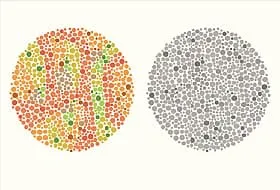When you’re colorblind, basic tasks like driving or picking a ripe apple can get a lot harder. But they don’t always have to be. From labeling your clothes to using apps, there are a lot of ways you can make your life just a little easier.

General Tips
For help on several fronts, you might want to:
- Ask about special contact lenses or glasses. They won’t solve every problem or make you see normally, but check with your doctor to see how they might work for you.
- Focus on lighting. If you can control the lighting in your house, cube, or office, do it. Plenty of bright, natural light is best, and try to avoid glare.
- Use smartphone apps. They can name colors for you, make it easier to tell colors apart, and even show your friends and family how you see the world.
Tips for Everyday Tasks
These ideas can help with everyday challenges.
Choosing clothes. When you go shopping, try an app to help you pick clothes. Some of these apps let you take a picture of the item and find out the color and its shade. Otherwise, you’ll need to count on friends, family, or a salesperson.
Once you’re at home, you can use a system to know which clothes match. Ask a friend who’s not colorblind to help you label your clothes. You can also organize your closet by items that go together. Once it’s set up, you can manage it on your own.
Cooking meat. Food safety experts will tell you that color isn’t the best way to judge when your steak is done. Or your roast, pork chops, turkey, or other meats.
Your best bet is to get a thermometer and a chart that shows the right temperature for cooking different meats. For example, cook:
- Chicken breast to 165 F
- Hamburgers to 160 F
- Medium-rare steak to 145 F
Dealing with electronics. Red means your battery is low. Green - that it’s charged. And if you can’t tell the difference?
Electronics can give you fits. For simpler devices, there may be no getting around it. But sometimes, you can set up sounds or other cues instead. For example, Apple computers have a setting called “Differentiate without colors.” Check that box and you’ll get shapes to guide you instead of just colors.
Smartphones have options, too. On iPhones with iOS 10 and later, you can use color filters to help you tell colors apart. And Android phones running version 5.0 and higher offer color correction that you can set based on what colors you’re able to see.
Handling school challenges. If your child is colorblind, it’s hard to color grass when they don’t know which crayon is green. The first step is to talk to the teacher, and explain how you, or your child, sees color.
From there, you can ask the teacher to:
- Create handouts that use only black ink on white paper
- Label paints and other art supplies with basic names -- “olive” isn’t useful, but “dark green” is
- Let you sit front and center so you have a good view of the chalkboard
- Use labels or patterns for tasks that rely on color, like “red triangle” instead of just “triangle”
- Write with only white chalk on a blackboard and only with black markers on a whiteboard
Managing at work. Charts, graphs, and presentations that burst with color can make your job almost impossible. Start by talking to your manager and co-workers to help them understand what you need.
You can ask that images and graphs always have labels and text to fully explain them. You can also send along links from software makers for how to create materials that are more useful to you. For example, Microsoft has tools and tips on designing PowerPoint slides that work well for people who are colorblind.
For some jobs, like doctors and pilots, you can find online groups for tips on how to work around common issues. Many people with problems seeing colors can be certified as pilots. Others get certain restrictions involving flying at night.
Picking fruits and vegetables. Tired of biting into unripe bananas? For a lot of fruits and veggies, you can look for other signs. Pineapples should feel heavy, smell sweet, and have leaves you can pluck off easily. You want asparagus with tight buds and straight stalks. And avocados need to have a little give, but not too much, when you press on them.
You can search online or ask a worker at your grocery store for more help with your favorite fruits and veggies. And if you can’t get around color, the right app on your smartphone might help.
Reading traffic lights. You’ll have to rely on position, not color. For traffic lights that go top to bottom:
- Top is stop
- Middle is caution -- the light’s about to change
- Bottom is go
For traffic lights that run left to right:
- Left is stop
- Middle is caution
- Right is go
Understanding test results. There are a lot of tests out there that use color to show results, like for swimming pools and garden soil. In some cases, you can find kits that use a digital display instead.
If not, you may be able to find an organization, like a local college, to run the test and give you results you can use.

